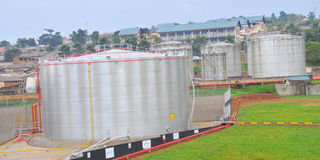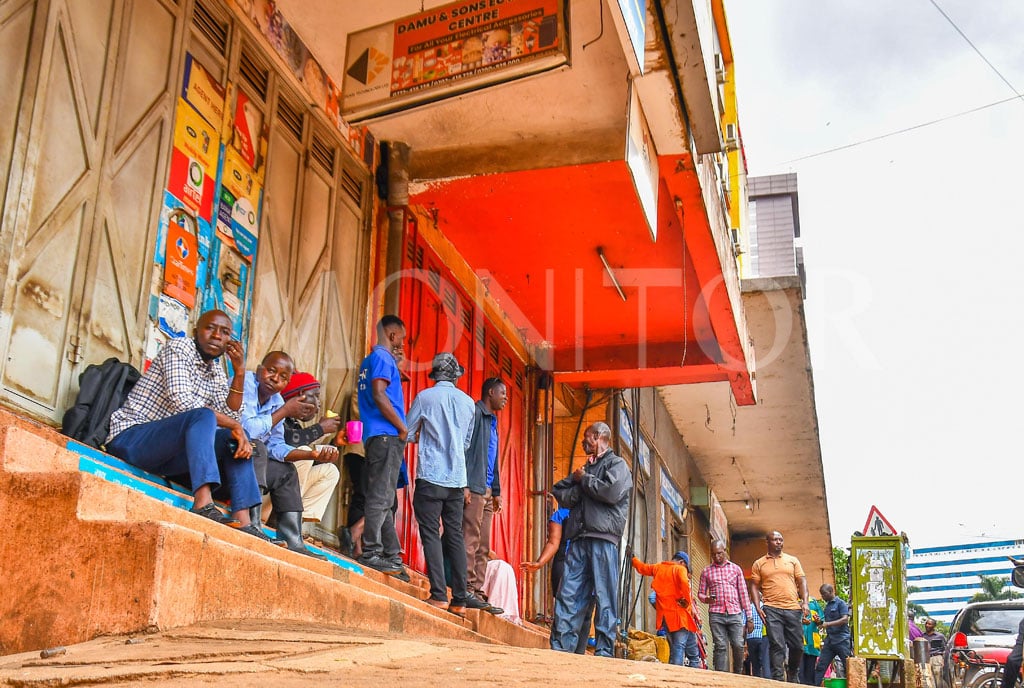Are fuel depots in the city a ticking bomb?

What you need to know:
In Kampala and Uganda, petroleum depots keep springing up in different areas that are frightfully close or within human activity points. How safe are you?
Imagine having a home, your child’s school or even that hospital at which a family member or friend is admitted, being situated within the vicinity of a highly combustible storage tank – with millions of litres of fuel.
The mere thought of it sends shivers down anybody’s spine. Trying to fathom it makes you cringe.
Maybe there is cause to dread the worst. On December 11, 2005, a series of explosions at the Hertfordshire Oil Storage Terminal left a total of 43 people injured at Buncefield in the United Kingdom.
The terminal was the fifth largest oil-products storage depot in the United Kingdom, with a capacity of about 60 million gallons of fuel. The terminal is owned by Total UK Limited which had 60 per cent stake and Texaco with 40 per cent.
The worst case scenario would have been if that depot was located in a residential area. The casualties would have been much higher. Yet careful and prudent planning averted that. The terminal was just an industrial complex surrounded by the expansive Buncefield – separating human settlement from the fury of the explosion by miles.
Much as the distance curtailed the danger to human life, it did not diminish the magnitude of the event. The explosion did send deep earth waves that could be detected at seismograph stations across the UK and the Netherlands and on infrasound arrays in the Netherlands.
Seismologists using array micro-barometers estimated that the explosion carried a yield the equivalent of 29.5 tonnes TNT.
To put that into perspective, the worst industrial accident in United States history carried the equivalent of 1.134 kilotonnes of TNT and that was at the refineries and oil storage tanks of the Monsanto chemical plant burn in the waterfront area – a hub of human activity – in Texas City, on April 16, 1947, 581 died, and more than 5,000 were injured.
Since then, safety and precaution at oil depots has improved. However, picking from the two incidents and applying the old adage of “better safe than sorry”, wouldn’t one rather have a Buncefield rather than a Texas situation? In Kampala and Uganda in general, petroleum depots keep springing up at different areas that are frightfully close or in the human activity and settlement points.
In Namuwongo, a Kampala suburb, Vivo this year set up 10 million-litre capacity tanks atop the hill. Much as Namuwongo is gazzetted as an industrial area, it is still a hive of human activity with schools, businesses and even a hospital within the locality of the tanks.
Fire says

One of the fuel tanks on 8th Street Industrial Area surrounded by a residential area. PHOTOs by joseph kiggundu
Uganda Police Fire department director says, “There are specific points that I am worried about.”
He adds, “There are those storage tanks in Namugongo but it is Banda Tanks that pose the greatest risk,” notes Joseph Mugisa.
“They are located in an area where they should not be and their positioning means that in an event of an accident the lives of hundreds or even thousands of slum-dwellers below and the surroundings would be in immediate danger. The people who approved the installation of those tanks shouldn’t have.”
The Banda MOGAS tanks are on a hill slope followed by a slum that stretches into the valley with considerable human population. Above the tanks is a main road; the Nakawa-Banda- Bweyogere route.
“I fear that one day a vehicle may veer off the road and into the tanks as the main route above the tanks also features a junction and that place is susceptible to accidents or one of the petroleum trucks maybe delivering the product to or from the tanks and its breaks fail,” says Mugisa.
“It will ram down into the tanks and trigger an explosion.”
Mugisa says the consequences of such an event and its toll on human life would be unimaginable.
“That would be a very dangerous situation. I cannot envisage the exact degree of danger but would be safe to say it would be high,” he notes.
“Last year, explosions from petroleum tanker involved in an accident along the Northern Bypass killed 40 people injuring many. That was just about six to 7,000 litres of fuel. Imagine the carnage on both property and human life the 300,000 to a million litres that these storage tanks would leave behind.”
To stem the gravity of the issue, Mugisa also alludes to 1973 incident where 13 people were killed in the explosion of a petroleum tanker with a capacity of 3,000 litres after having been involved in an accident in Nakivubo.
“Those accidents involved tankers of low capacity, yet the causality figures were high. In the 1980’s in a Mexican city, explosions at six petroleum storage tanks killed over 500 people and the entire neighbourhood had to be evacuated,” recalls Mugisa. “I think that gives a picture of the devastation that these storage depots can cause.
“We can marshal all our resources but that may not be enough. Such accidents the fires and explosions are usually spontaneous and the effects swift and our response time may not be as fast as expected due to difficult accessibility along the routes where these storage tanks are,” the fireman says.
“Take an example of the Banda tanks, for our fire trucks to make it across the Jinja Road route – which is usually laden with traffic jams – we would have to close down the entire route which would take time and lives would be lost with every minute that drags on.”
Greenhill Academy, a school that hosts over 3,000 pupils and students daily is only about 250metres from the tanks in Namuwongo. The safety zone – a distance between tanks and barrier/fence is only about 100 metres.
“We are not comfortable with the storage tanks springing up around our school that’s been in place for 20 years now. They have put us on heightened alert and we usually carry out fire drills to ensure we are prepared in case of any fire outbreaks be it external or internal,” says Joy Maraka, the rector, Greenhill schools.
Who is responsible?
Maraka says, “KCCA as the regulatory organ in the licensing of these companies has to answer because we sit on mailo land and it is not gazatted for industries, so they should at least be considerate of our existence when picking the location of these structures.” In an ideal setting, the National Environmental Management Authority (Nema), would wield the power to remove the petroleum depots out of such localities, unfortunately, it holds no sway over who sets up a depot.
“In the Kampala case, the issue of where such depots are set up falls beyond our mandate and burden of risk assessment is usually undertaken by the urban planner who is KCCA,” notes Naome Karekaho, the Nema spokesperson.
Initially, promotion and regulation of the oil and gas sector has been undertaken by the Ministry of Energy and Mineral Development through the Petroleum Exploration and Production Department, (PEPD).
But under the National Oil and Gas Policy, the ministry will handle the policy aspects, while regulatory and commercial aspects will be handled by Petroleum Authority of Uganda (PAU) and Uganda National Oil Company (NATOIL) respectively.
“Once the request for location ticks all the safety boxes and the urban planner KCCA has approved in consultation with the responsible entities, we usually sign off as well,” says Karekaho.
However Robert Kalumba, a publicist with KCCA says City Hall has persons that monitor the construction of not only petroleum storage facilities but construction in general.
“The monitoring is in the form of whether you have adhered to the approved construction plans that you submitted to KCCA,” he explains attributing the current state of affairs to poor supervision by past Kampala City Council regimes that allowed these areas to have been ‘encroached’ on by different people including residential properties.
Kalumba says fuel tanks existed before other developments in the Industrial Area. “These facilities existed in the Industrial Area Corridor; an area which was zoned to have such facilities like industries,” he explains.
“In other words the Industrial Area Corridor is zoned to accommodate such facilities like petroleum storage tanks and not residential, office structures or schools,” he states.
Whatever the case, whether in an industrial area or not, the proximity of these tanks to human remains a radioactive safety issue and one that needs urgent insight.
These accidents may not be an everyday but when they have happened, history tells of great loss of human life. A better planning mechanism needs to be sought therefore.
What are the standards?
Hans Paulsen, the managing director of Vivo Uganda, who have the biggest tank located in Namuwongo suburb however says, “As part of our business operational standards for setting up depots, we conduct a detailed Environmental Social Impact Assessment (ESIA) with the authorities before undertaking the investment. Once the necessary approvals have been achieved, mitigations measures are put in place to combat any potential impacts of operations.”
The petroleum (refining, conversion, transmission and midstream storage) Act, 2013, Section 67 says all storage facilities of this nature must have a safety zone surrounding every facility
Whether the 100 metres is enough to ensure safety is a preserve for history to judge best. The accidents in Texas and Buncefield had far-reaching effects, well beyond the 100 metres subscribed to.
Brian Lubega, an urban surveyor based in Kampala says most developers overlook the safety requirement and prefer setting up the tanks in areas busy with human activity especially along the roadside as a cost saving measure and also to increase their visibility.
“Developers like such sites. They want people to see their brand more and also cut on costs. Imagine the costs they would incur on transportation, if the storage tanks were far removed from town or a main road,” he explains.
“Another risk lies in setting up these tanks atop hills. In case of an explosion, that alone makes the dispersion of the toxic fumes easier.”




